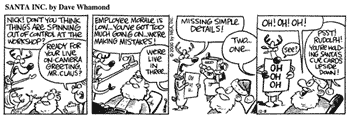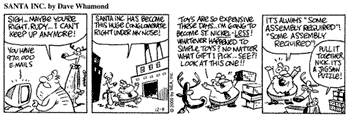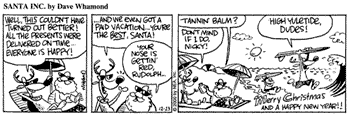 |
|
|
Opus 43: 2. Still on the Stands (12/20) 1. Anyule Greetings. Ever since 1937, the NEA syndicate (Newspaper Enterprise Association, now part of United Media) has offered as a part of its service to subscribing papers a 3-week Christmas comic strip. I remember these fondly. (In fact, there is a remarkable coincidence in the inaugural year 1937, a coincidence I’ll refer to only obliquely in passing. Like this.) I remember the one in which Rudolph the Red-nosed Reindeer appeared. It had to have been in the early 1950s because the song had just started to din into the public ear. Rudolph had actually been around since 1939. The poem was written by Robert L. May, a Chicago copywriter for Montgomery Ward, which published it as a promotional pamphlet that year. May’s boss almost killed the idea: he thought Rudolph’s having a red nose would get everyone thinking about alcoholism. Luckily, an art department genius made a trip to the Lincoln Park Zoo and drew up some reindeer, giving one a slightly bulbous nose and tinting it red. The illustrations so charmed May’s boss that he approved the project, and Montgomery Ward distributed the pamphlets to its customers annually for almost a decade afterwards. In 1947, the pamphlet was published as a book, and a short animated cartoon appeared in movie theaters. But it was May’s brother-in-law, songwriter Johnny Marks, who sent the ruddy-nosed reindeer into orbit. He set the poem to music, and in 1949, Gene Autry (the cowboy crooner--you remember) did the recording that sold two million copies and lodged Rudolph in the popular culture Christmas ever after. And shortly after that, NEA gave Rudolph a big part in its Christmas comic strip. Actually, I was a little disappointed at the artwork on this one; seems to me that Walter Scott illustrated a serial text Christmas story that ran in the Denver Post for the previous few Yuletides, and I missed his distinctive style. Instead, we had someone who drew like Bugs Bunny’s Ralph Heimdahl--quite competent, don’t misunderstand; but I liked Scott’s little people (the elves) and his liquid line better. This year, nothing daunted, NEA/United Media again offered its traditional holiday strip. Called Santa, Inc., this year’s effort was master-minded by Dave Whamond, otherwise creator of Reality Check, a daily panel cartoon. Whamond is Canadian by birth and rearing. He discovered doodling at an early age and he’s still at it: his loose cockamamie style is but a sophisticated refinement of a doodle. A real cartoon style, in other words. As we joined Santa at his North Pole factory on December 4, he’s discussing the morale problem with Rudolph. The elves are over-worked, and Santa’s production schedules are unrealistic. And they never get a day off. Work, work, work. Faced with a rapidly deteriorating situation, Santa brings in a consultant, Frosty the Snowman. Rudolph isn’t keen on the plan: he remembers the year Santa brought in a Swedish guy as a consultant. "What was his name?" Rudy muses. "Olaf--the other reindeer. How could I forget. All he did was laugh and call us names." Yup. That’s the sort of bad pun you get, day-after-day. But as far as I’m concerned, bad puns put me in a better holiday spirit than counting the shopping days left. ("Olaf" sounds like "all of"--get it? Read the rest of the line.) Eventually, Frosty succeeds in reminding Santa’s crew why they got into the elf business in the first place: "You loved what you did, and I think that love is still somewhere deep inside you all!" Presto, in the very next panel, the elves unearth their buried love and all dash about, singing while they work. Crisis over. The Christmas spirit reigns. Santa makes his deliveries on time, and he and the elf crew and Rudy and the other reindeer get to vacation (for a change) on the beach in what might be Hawaii. The anyule NEA strip is always about like that. Claus-trophobic: a Santa crisis in the first few days, mounting confusion and distress for the next couple weeks, and finally, a "Merry Christmas" conclusion. Who could ask for more? I don’t want to be greedy, but I found some more in a DC Universe Christmas package: seventeen stories gleaned from comic books published over the last sixty years--4 from the forties, one each from the sixties and seventies, 3 from the eighties, and 8 from the last decade. Here’s Frank Miller drawing a Denny O’Neil Batman tale from late 1979 (just after Miller had started hitting his stride over at Marvel on Daredevil), Ty Templeton showing what happens when Santa drops in on Darkseid in 1998, Nick Cardy giving us his interpretation of Dickens’ Scrooge in 1968, and John Bryne doing an Enemy Ace tale entirely without words in 1988. The package appeals, too, to the nostalgic sentiment that lurks at this season. Jack Burnley renders a Jerry Siegel Superman story from 1940, when Superman still looked like Joe Shuster’s version. And here’s Pete Costanza doing Captain Marvel in 1947. It’s always nice to see the Big Red Cheese in his traditional style, but here the reconstructed black lines have thickened up, virtually destroying the clean, uncluttered appearance of the vintagae Captain Marvel books. Here’s a Wonder Woman story from 1943 by William Moulton Marston and H.G. Peter. Peter’s art is crisper than I remember; and Marston includes a half-dozen bondage scenes to enliven the holiday. (And in one, Wonder Woman gets about as explicit as possible in juvenile literature: "Stop spanking me," she exclaims, "I’ll be good." What a hoot!) The best in the package comes from Jose Luis Garcia-Lopez, who pencils a 1980 Legion of Super-heroes piece by Paul Levitz, enhancing the tale with his lively layouts and unusual perspectives; and from Ronnie del Carmen, whose treatment of Paul Dini’s 1995 Batman tale with Harley Quinn and Poison Ivy brims with inventive visual comedy and bouncing energy. The older holiday stories fall into traditional patterns, mostly sentimental, while the more recent material tends to be moralistic in a fairly sophisticated way, picking up an ethical thread in a single commonplace incident rather than tacking on a "Merry Christmas" ending to a crime-fighting tale. But old and new, the stories give an evening’s reading a nicely festive glow. And finally, speaking of elves, we have a new Christmas tale, The Forgotten Helper, by Lorrie Moore, an English professor at the University of Wisconsin at Madison. The helper in question is one of Santa’s, a somewhat cranky old elf named Aben, who gets stranded in a not-so-nice little girl’s house on Christmas Eve and must spend the entire ensuing year there. His only hope of getting back to his native habitat at the North Pole is that Santa will stop next time around and pick him up, but Santa is not likely to stop unless the little girl gives up her naughty behavior. So Aben sets about to get her to be better behaved. The text is infused with a sort of Britishy tone and we are pummeled with quirky quaintnesses of the sort that might appeal to Harry Potter fans--Aben takes up residence in the attic of the house, using discarded buttons and whatnots to furnish his "apartment." But upon what does this miniature being feed? Alas, a critical detail left dangling, Lorrie. My chief interest in the book, however, resides in the illustrations provided by T(no period) Lewis, who, in another life, draws with an exquisitely eccentric line the altogether excellent comic strip, Over the Hedge, for Michael Fry. (And if you aren’t yet a fan of this one, you should be; three reprint volumes have been issued by Andrews McMeel, and you can inquire at tollfree 800-826-4216.) Lewis’s drawing style in this book is quite different from the one he employs on the strip. Here, a little suggestion of Arthur Rackham wafts by; ditto a shade of Norman Rockwell. Mere auras, mind you, not imitation: Lewis’s manner is clearly his own. And the book is worth owning for the pictures alone (Delacorte Press, $12.95; ISBN 0-385-32791-9, 82 5x8" pages in hardback). What’s Christmas Morning without a new book under the tree? Don’t leave yourself out. And--rest ye merrie. 2. Still On the Stands. If you dash right out, you can probably still find a copy of Time magazine for December 18 on the newsstand--and, perhaps (depending upon how esoteric your newsstand is), a copy of a little square-bound magazine entitled Rosebud. In that miscellaneous collection of newsy bits that begins each issue of Time these days, we find "Truth, Justice, and the Catholic Way," an article wherein it is announced that the Vatican has approved a comic book version of Pope John Paul II’s life. "With emphasis on his soccer-playing, ski-slope-bombing youth in Poland," the comic seeks to appeal to young Catholics by proving that the Pope "really wasn’t a geek." Time then proceeds to compare the Pope to other comic book heroes--namely, Batman and Superman--finding that they all have much in common. They all wear capes and have alter egos (the Pope’s real name is Karl Wotjyla) and tragic pasts (death of parents at an early age--John Paul’s mother when he was nine). Both Batman and the Pope have cool transportation (the Batmobile and the Popemobile), and all three heroes have super-normal powers: Batman, highly developed physical prowess and reflexes; Superman, faster than a speeding bullet, etc.; the Pope, "transubstantiation" and a "hot line to Jesus." Finally, all three face archenemies: Batman, the Joker, the Riddler, the Penguin; Superman, Lex Luthor, Brainiac; the Pope, "Communists and Beelzebub." In the same issue, we have "The Drawing Board," a regular comic strip feature, this issue by Atlanta Constitution editorial cartoonist Mike Luckovich, who makes his appearance in these pages once a month. This installment features panda bears and their lawyers, James Baker and David Boies (nifty caricatures), trying to gain admission to the Washington, D.C. zoo on the grounds that "the zoo animals intended to vote for pandas but voting was overseen by a bunch of apes." Luckovich has just concluded another comic strip stint. Last year Tribune Media Services launched his satirical Superzeroes strip (featuring a diminutive wiseacre and a somewhat dense hulk, both in longjohns). But when Luckovich discovered he was about to become a father for the fourth time, he realized he wouldn’t have time to do the strip, his Constitution cartoon, the monthly gig at Time, and take turns changing diapers; so he discontinued Superzeroes in November Rosebud is "the magazine for people who enjoy good writing," it says on the cover, and the current issue (No. 18) is the Cartoon Issue, which, ipso facto, dubs the cartoons therein as "good writing." And some of the cartoons are good drawings, too. Represented are Robert Crumb (with a Mr. Natural and Flakey Foont sequence originally done in 1997), Joost Swarte (with three full-page single-panel cartoons), Mitch O’Connell and Chad Carpenter and his brother Darin (with multi-page strips), and an assortment of strips by Leslie Moak Murray from her newspaper feature. These are the more-or-less well-drawn pieces. Murray’s work looks like she’s over-dosed on Jerry Van Amerongen’s Ballard Street or The Neighborhood. Her line is a little less bold, but the stuff is funny. Carpenter’s manic comedy is enacted by funny animals of the Scott Shaw! breed: he does his version of Moby Dick and then The Wizard of Oz, complete with triple-takes and falling over backwards humor. O’Connell illustrates a biography of himself written in 1993 by Rick Kogan; nice, crisp black and white pictures but no recurring characters. Mostly buildings and street scenes. Meanwhile, we have P.S. Mueller and Michael Shaw, two cartoonists who have recently cracked gag cartooning’s holy of holies, The New Yorker. Both make feeble-line scrawls of the sort that has lately infected the magazine where Peter Arno, Charles Addams, George Price, and Gluyas Williams once appeared. Well, so did James Thurber, and these two newcomers are more in his class. Shaw also offers a two-page essay about his having won a cartooning contest sponsored by the Algonquin Hotel (where, around the legendary round table, the city’s journalistic gossips tossed barbs back and forth and egged Harold Ross on to found The New Yorker, which he did, expecting other roundtablers to help him; they didn’t--much). Given the frequency with which the magazine is mentioned throughout Rosebud, it is evident that the editors hope to somehow emulate Ross’s magazine. To that end, they offer some short fiction and poetry. All of it is pretty lukewarm, but the cartoons are at least comical. And quite a few are well drawn. Unfortunately, the dimensions of the magazine’s 7x10-inch pages don’t allow much display room. Carpenter’s stuff fares badly as a result, but O’Connell’s tiny street scenes do pretty well; ditto the simple-line art of Mueller, Shaw, and Murray. Rosebud may someday live up to its subtitle, but for the moment, it’s just a wonderful curiosity--and a balm to cartoonists everywhere who may wish their work to be treated as seriously as fiction and poetry. And that, in fact, is the reason we pause here at the namesake of a sled: it’s nice to see cartooning being treated respectfully. And with Time and Rosebud, we see, perhaps, the dawn of that new age. Happy new year. To find out about Harv's books, click here. |
|

send e-mail to R.C. Harvey Art of the Comic Book - Art of the Funnies - Accidental Ambassador Gordo - reviews - order form - Harv's Hindsights - main page |


